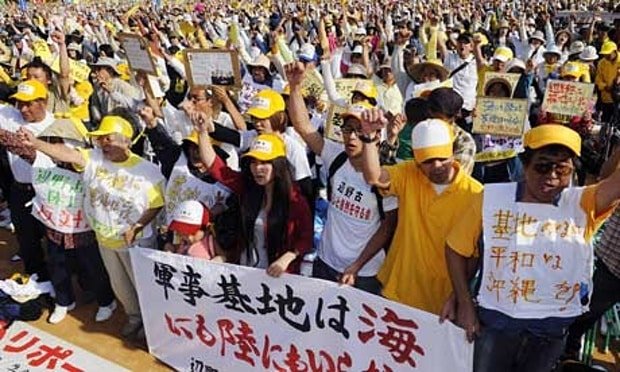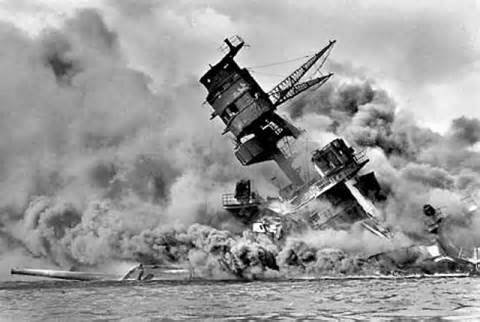DISCLOSURE: VT condemns the horrific tragedy committed by the NAZI Party against Jewish Citizens of Europe during Word War II known as the "Holocaust". VT condemns all racism, bigotry, hate speech, and violence. However, we are an open source uncensored journal and support the right of independent writers and commentors to express their voices; even if those voices are not mainstream as long as they do NOT openly call for violence. Please report any violations of comment policy to us immediately. Strong reader discretion is advised.
![]() by Jonas E. Alexis
by Jonas E. Alexis
If you have seen the popular movie Pearl Harbor, then you understand that the regime has been brainwashing the masses and distorting historical facts in the entertainment industry.
Pearl Harbor basically begins with the thesis that “Adolf Hitler builds the German military machines and drags all of Europe into war.” Why? Well, the movie gives the impression that he wanted to conquer much of the world. Even as late as 2011, some writer in the Daily Mail fantasized that Hitler could have invaded America.[1]
Nothing could be further from the truth.
Pearl Harbor, which is more than three hours, puts a big lie in the minds of its viewers and never addresses the deeper issue, namely, Germany reluctantly entered the war and finally had to do so because of massive debt, economic collapse, cultural degradation, and sexual debauchery and sodomy. (We have addressed these issues in the past.)
Moreover, the movie never addresses the inescapable fact that the Allied literally crippled the entire German economy right after World War I and divided Germany itself:
After about an hour, the movie moves on to the inexorable truth: the Japanese attack on Pearl Harbor was not provoked at all. The Japanese wanted a war because they wanted to get us involved in World War II. The U.S., we are told, exhausted all possibilities to reach a peaceful resolution with Japan.
Later in the movie, we are told that “America still awaits Japan’s response to peace proposal.” In other words, it was their fault that we dropped atomic bombs in Hiroshima and Nagasaki in 1945.
The simple fact is that long before we went to war, the U.S. spent months provoking Japan.[2] More importantly, what happened to Japanese women and other innocent people who had nothing to do with the war?

Well, historian Thomas Goodrich has taken the challenge to answer that vital question. Intellectual historian Mark Lilla of Columbia University writes that “Whoever takes it upon himself to write an honest intellectual history of twentieth-century Europe will need a strong stomach. But he will need something more. He will need to overcome his disgust long enough to ponder the roots of this strange and puzzling phenomenon.”[3]
Thomas Goodrich has done just that. In fact, Goodrich is not your typical historian. Unlike Stephen Ambrose, Richard J. Evans, and others who have been making money by blending a little bit of truth with a torrent of lies, Goodrich is not afraid to dig historical facts and tell you what actually happened. As he told me just recently:
“I like researching where others dare not go politically, but I also like digging up the details of history that others are too lazy to go after, as per my book on the Lincoln assassination, the darkest dawn. I have been genuinely hated by the academic court historians for rocking their boats……and I love it. If they ain’t hatin’ me, I ain’t doin’ my job. If you don’t get flak and triple A, you are not over the target. Just exactly like your job at VT… Everyone in the history world knows that I am an exhaustive researcher. I like going where others fear to tread.”
Goodrich is one of the few people who reminds me of a rhetorician and satirist by the name of Lucian (AD 125-AD 180), who bravely said:
“If you are going to write history you must sacrifice to truth alone, ignoring everything else…Well, my historian should be like that: fearless, incorruptible, frank, a friend of free speech and the truth, determined, as the comic poet puts it, to call figs figs and a tub a tub, indulging neither hatred nor friendship, sparing nobody, not showing pity or shame or diffidence, an unbiased judge, kindly to everyone up to the point of not allowing one side more than it deserves, a stranger without a stake in his writings, independent, serving no king, not taking into account what any man will think, but simply saying what happened…
“On the whole, I ask you to remember this—and I shall keep on repeating it: don’t only write with an eye to the present, hoping that the present generation will praise and honor you. You should aim at eternity, writing for posterity and claiming payment for your book from them; so that it can be said of you: ‘He was a free man, totally frank in his speech, untouched by flattery or servility, showing truthfulness in everything.’”[4]
If you have read Hellstorm: The Death of Nazi Germany, 1944-1947, then you understand that no praise can be too high for Goodrich as a historical writer. He has just told me that Hellstorm will be translated into German, Spanish, Italian, Russian, Ukrainian, and French. We should all welcome that enterprise, for it will certainly wake people up from their dogmatic slumber.
Goodrich is also a prolific writer and has written a wide range of historical works, including Black Flag: Guerrilla Warfare on the Western Border, 1861-1865 (Bloomington: Indiana University Press, 1995).[5] But Goodrich has recently raised an issue that got me thinking a little. The U.S. spent months provoking Japan during World War II, and Japan responded with an attack on Pearl Harbor in December of 1941. Instantly, the war machine began to call the Japanese “dirty rats,” “yellow monkeys” and “sneaky Japs.” Goodrich writes:
“In the anti-Japanese furor that swept America following Pearl Harbor, in the hyper-heated madness to exact revenge for the attack, rare was that American who paused to consider that perhaps the impetus behind Pearl Harbor was the months of deliberate and humiliating aggression directed at Japan by the Franklin D. Roosevelt administration, including the embargo of vital raw materials without which Japan was doomed to collapse as an industrialized nation.
“Well before December 7, 1941, such sanctions were correctly viewed by the proud Japanese leadership, as well as the world, as a de facto declaration of war by the United States. Also, though few were aware at the time, it has long since been known that Roosevelt and others in the US government were well aware of the coming attack in the central Pacific.
“Nevertheless, because of Japan’s military pact with Nazi Germany, Roosevelt and his Jewish ‘advisers’ desperately hoped that backing the Japanese into a corner would provoke just such a response resulting in the United States entering the European war via the ‘back door.’ In that case, the U.S. would then join with Britain and the Soviet Union to crush Hitler and Germany.”
Once again, Americans listened to the propaganda machine and began to rally behind Roosevelt to enter into a bloody conflict with Japan. It must be noted that “In 1914 90 percent of the American people had been against entering the war.”[6] So, Roosevelt obviously had to find a way to manipulate Americans.
Keep also in mind that Roosevelt was a flaming Zionist. “He publicly backed a Jewish homeland in Palestine and pressured the British to keep Palestine open to Jewish immigrants.”[7] Right after the attack on Pearl Harbor, it became quite easy for Roosevelt to bludgeon America into World War II. As Goodrich puts it:
“Thus, and almost on cue, the ‘sneak’ attack at Pearl Harbor and the ‘date which will live in infamy’ was used by the propagandists as a rallying cry to whip the American people—who had been decidedly against war—into a frenzy of anger, hatred, and revenge.”
Does that sound familiar? Didn’t the powers that be use the same covert operation to invade Iraq in 2003?
To make a long story short, America got into a bloody conflict with Japan shortly after the Pearl Harbor attack and began to apply Ehrenburg-style methodology.[8] One marine colonel told his men:
“You will take no prisoners, you will kill every yellow son-of-a-bitch, and that’s it.”
Sadly, U.S. soldiers did just that. Goodrich writes:
“Understandably, Japanese soldiers had no more desire to surrender and be tortured than did US soldiers fighting the Indians on the Plains of America a century earlier. Each fought to the finish, but each also saved the ‘last bullet’ for themself. If a Japanese soldier found himself surrounded with no way to escape or kill himself, he committed ‘suicide’ by walking calmly back and forth along the enemy lines until a bullet found its mark. Sometimes ten, even twenty, Japanese would thus kill themselves simultaneously…
“Not only were there virtually no survivors among the 30,000 men of the Japanese garrison on Saipan, but two out of every three civilians—some 22,000 in all—were either murdered or committed suicide.
“‘We just blew it all up,’ admitted one marine. ‘We don’t know if there were women and children or whatever, we just blew them up.’”

The ehrenburg-style killing was just the tip of the iceberg. Rape was the next step:
“Because the great bulk of fighting in the war against Japan was fought on the water, in the air or across islands either uninhabited or sparsely populated, rape is a word seldom mentioned in American war diaries or official reports during the years 1941-1944.
“When US forces invaded the Japanese island of Okinawa, however, this changed. Almost immediately, and in spite of the bloody fighting, US soldiers began the sexual assault on the females of the island. In one prefecture alone, during a ten-day period, over one thousand women reported being raped.
“Since most victims would never come forward and voluntarily suffer such shame in a society where modesty and chastity were prized above all else, the number of rapes was undoubtedly much greater than reported.”
Goodrich moves on to give this gruesome example:
“Marching south, men of the 4th Marines passed a group of some 10 American soldiers bunched together in a tight circle next to the road. They were ‘quite animated,’ noted a corporal who assumed they were playing a game of craps. ‘Then as we passed them,’ said the shocked marine, ‘I could see they were taking turns raping an oriental woman. I was furious, but our outfit kept marching by as though nothing unusual was going on.’
“So pervasive was the crime, and so frightened were the people, that hundreds of Okinawa women committed suicide by swallowing poison or by leaping from the steep cliffs of the island.
“Japanese officials were so concerned about the mass rape of their wives and daughters by the victors that they rounded up tens of thousands of girls from poorer families throughout the nation and all but forced them into prostitution at various brothels, or ‘comfort stations.’
“Although such stop-gap measures did prevent wholesale rape on a German scale, this was small consolation to the women and children who had to endure the sanctioned sex attacks. Earning anywhere from eight cents to a dollar a day, a girl working in the “rape stations,” as they more commonly were called, might be brutally raped and sodomized from 15 to 60 times a day.”
One girl testified: “They took my clothes off. I was so small, they were so big, they raped me easily. I was bleeding, I was only 14. I can smell the men. I hate men.”
You may want to hang onto something to read the next excerpt:
“In the Spring of 1946, American GI’s cut the phone lines in Nagoya and raped every woman they could get their hands on, including children as young as ten. At another city, US soldiers broke into a hospital and spent their time raping over 70 women, including one who had just given birth. The mother’s infant was flung to the floor and killed.”
Now here is the rub: the U.S. cried crocodile tears when Japan hesitated to apologize for past war crimes. “Even before a United States Congressional panel overwhelmingly passed a resolution on Tuesday urging Japan to apologize for its wartime sex slavery, the Japanese government said it would have no comment.”[9]
Japan is guilty of wartime sex slavery; the U.S. is guilty of wartime sex slavery. But it is Japan that needs to apologize, not the U.S.
Balderdash.
Government officials in Japan probably didn’t have time to comment because they had to puke. Japan is still carrying a huge burden on its back. The Guardian declared in 2012 that between 1972 and 2009, long after the war was over,
“there have been 42 crashes of US aircraft, 37 cases of falling parts, 328 emergency landings, 17 landing failures. For Londoners, it would be like having F22s landing in Hyde Park.
“Then there are the rapes, muggings, and burglaries committed by US servicemen – 5,634 criminal offenses between 1972 and 2009. Among them are 25 murders, 385 burglaries, 25 arsons, 127 rapes, 306 assaults, and 2,827 thefts. The worst was the rape of a 12-year-old schoolgirl in 1995.”[10]
Will the U.S. apologize for that?
Kirk Spitzer of the Time was astonished that in 2012, Japan did not want to apologize for what happened in World War II.[11] (Actually, they apologized numerous times in the past.[12] They continue to apologize to this very day.[13]) In order to make a point, Spitzer interviewed Jewish scholar Thomas U. Berger, who made this risible statement:
“Japan has offered relatively little compensation to the victims. And to this day there are no nationally sponsored museums or monuments that acknowledge Japanese aggression or atrocities.”[14]
During the interview, Berger made some interesting points, but here he was just carrying his own casket. What kind of compensation did millions upon millions of Christians receive from the former Soviet Union? Did Berger forget about The Red Holocaust?[15] I am still waiting for a nationally sponsored museum that actually acknowledges the blood of my brothers and sisters who died during that era. What is equally disgusting is that Benjamin Netanyahu declared in 2010 that he aspired to build a monument to commemorate the Red Army![16] Former President Shimon Peres added this diabolical statement:
“This is an opportunity to thank the Red Army. Had it not defeated the Nazi beast then it is doubtful we would be standing here today. In World War II the Soviet Union prevented the world from surrendering.”[17]
If Berger wants us to take him seriously, then he has to address this issue cogently. Until then, he will be ignored.
[1] “What if the Nazis had invaded America? Maps reveal how Hitler could have attacked the U.S. (as imagined by 1942 issue of Life magazine),” Daily Mail, September 1, 2011.
[2] See for example Robert Stinnett, Day of Deceit: The Truth about FDR and Pearl Harbor (New York: Touchstone, 2000).
[3] Mark Lilla, The Reckless Mind: Intellectuals in Politics (New York: New York Review of Books, 2001), 198.
[4] Lucian, Selected Dialogues (New York: Oxford University Press, 2005), 96, 197, 201.
[5] To be honest, I have not read that particular book.
[6] Cited in E. Michael Jones, Barren Metal: A History of Capitalism as the Conflict Between Labor and Usury (South Bend: Fidelity Press, 2014), 1210.
[7] Richard Breitman and Allan J. Lichtman, FDR and the Jews (Cambridge: Harvard University Press, 2013), 3.
[8] It was Ilya Ehrenburg who said of the Germans: “Germans are not human beings. Henceforth the word German means to us the most terrible curse. From now on the word German will trigger your rifle…If you have not killed at least one German a day, you have wasted that day. If you think that instead of you, the man next to you will kill him, you have not understood the threat. If you do not kill the German, he will kill you. If you cannot kill your German with a bullet, kill him with your bayonet. If there is calm on your part of the front, if you are waiting for the fighting, kill a German before combat. If you leave a German alive, the German will hang a Russian and rape a Russian woman. If you kill one German, kill another—there is nothing more amusing for us than a heap of German corpses. Do not count days; do not count miles. Count only the number of Germans you have killed. Kill the German—this is your old mother’s prayer. Kill the German—this is what your children beseech you to do. Kill the German—this is the cry of your Russian earth. Do not waver. Do not let up. Kill.” Alfred Maurice de Zayas, A Terrible Revenge: The Ethnic Cleansing of the East European Germans (New York: Palgrave Macmillan, 2006)m 40; Norman M. Naimark, The Russians in Germany: A History of the Soviet Zone of Occupation (Cambridge: Harvard University Press, 1997), 72; Antony Beevor, Berlin: The Downfall 1945 (New York: Penguin, 2002), 169; Richard Bessel, Germany 1945: From War to Peace (New York: Harper Perennial, 2009), 150; Joachim Hoffman, Stalin’s War of Extermination (Chicago: Theses and Dissertations Press, 2001), 235-236.
[9] Norimitsu Onishi, “Asked for Apology, Japan Plays for Time in Sex Slavery Standoff,” NY Times, June 27, 2007.
[10] David Hearst, “Second battle of Okinawa looms as China’s naval ambition grows,” Guardian, March 7, 2011.
[11] Kirk Spitzer, “Why Japan Is Still Not Sorry Enough,” Time, December 11, 2012.
[12] “U.S. and Japanese apologies for war crimes could pave way for nuclear disarmament,” Japan Times, February 5, 2014.
[13] Matthew Pennington, “Japanese firm to apologize to U.S. WWII veterans,” Detroit News, July 15, 2015; Scott Neuman, “Japan’s Mitsubishi Apologizes For Using U.S. POWs As Forced Labor In WWII,” National Public Radio, July 19, 2015.
[14] Spitzer, “Why Japan Is Still Not Sorry Enough,” Time, December 11, 2012
[15] See Steven Rosefielde, Red Holocaust (New York: Routledge, 2010); for similar studies, see also Jean-Louis Panne, Andrzej Paczkowski, et al, The Black Book of Communism: Crimes, Terror, Repression (Cambridge: Harvard University Press, 1999); Robert Conquest, The Harvest of Sorrow: Soviet Collectivization and the Terror-Famine (New York: Oxford University Press, 1987); The Great Terror: A Reassessment (New York: Oxford University Press, 2008); Sheila Fitzpatrick, Everyday Stalinism: Ordinary Life in Extraordinary Times—Soviet Russia in the 1930s (New York: Oxford University Press, 2000).
[16] Herb Keinon, “PM: Israel to erect Red Army memorial,” Jerusalem Post, February 17, 2010.
[17] Gil Shefler, “Putin, Peres unveil Netanya memorial honoring Red Army,” Jerusalem Post, June 26, 2012.

Jonas E. Alexis has degrees in mathematics and philosophy. He studied education at the graduate level. His main interests include U.S. foreign policy, the history of the Israel/Palestine conflict, and the history of ideas. He is the author of the new book Zionism vs. the West: How Talmudic Ideology is Undermining Western Culture. He teaches mathematics in South Korea.
ATTENTION READERS
We See The World From All Sides and Want YOU To Be Fully InformedIn fact, intentional disinformation is a disgraceful scourge in media today. So to assuage any possible errant incorrect information posted herein, we strongly encourage you to seek corroboration from other non-VT sources before forming an educated opinion.
About VT - Policies & Disclosures - Comment Policy




